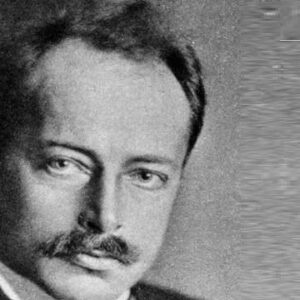Max von Laue, also known as Max Theodor Felix von Laue, was a German physicist who won the Nobel Prize in Physics in 1914 for discovering how crystals diffraction X-rays. As a result of this discovery, crystal structure has become a major focus of future research. The study of crystals led to the study of solid-state physics, which aided in the creation of contemporary electronics significantly. He proposed that an X-ray travelling through a crystal would be diffracted into several beams, resulting in a pattern on a photographic plate. The pattern would reveal the crystal’s atomic structure. He was a staunch supporter of Einstein’s ‘theory of relativity,’ and he conducted numerous experiments on quantum theory, atom disintegration, and the Compton Effect, which causes light to change wavelength under certain situations. He also contributed to the solution of superconductivity-related challenges. He was frequently called upon to provide advice in several areas of German scientific studies due to his ability to make accurate judgments. He was the sole one who supported the theory of relativity when Hitler came to power and objected when Einstein was compelled to resign from the Berlin Academy, at the risk of being ostracized.
Childhood and Adolescence
Max von Laue was born in the German town of Pfaffendorf, near Koblenz, on October 9, 1879. Julius von Laue, his father, worked for the German military administration. Minna Zerrener was his mother’s name.
Posen, Strasbourg, and Berlin were his educational destinations. Professor Goering introduced him to science while he was a student at a Protestant school in Strasbourg.
In 1898, he dropped out of school to pursue a year of military training. He studied physics, chemistry, and mathematics at the ‘University of Strasbourg’ after finishing his military training.
Career of Max von Laue
After a semester at the ‘University of Munich,’ Max von Laue joined the ‘University of Berlin’ in 1902 to work under Professor Max Planck. O. Lummer’s lectures on heat radiation and interference spectroscopy inspired him to conduct his own interference experiments.
After receiving his doctorate from the ‘University of Berlin’ in 1903, Max von Laue traveled to the ‘University of Gottingen.’ For two years, he worked under Professor W. Abraham and Professor W. Voight.
In 1906, he was offered a position as an assistant to Professor Max Planck at Berlin’s ‘Institute of Theoretical Physics,’ where he worked on thermodynamics and optics.
In 1909, he was appointed as a ‘Privatdozent’ at the University of Munich, where he taught thermodynamics, optics, and the theory of relativity.
In 1912, he became a professor of physics at the ‘University of Zurich.’ During this period, two of his pupils proved his hypothesis of diffraction of X-rays flowing through crystals under his supervision.
He became a ‘Professor of Physics’ at the ‘Frankfurt on Main’ in 1914 and stayed there until 1919.
He experimented with vacuum tubes, which were used in wireless communications and telephony, starting in 1916.
Under Einstein’s direction, the ‘Institute for Physics’ was founded in Berlin-Dahlem in 1914. In 1917, Laue was promoted to Deputy Director.
In 1919, he was named director of the ‘University of Berlin’s Institute for Theoretical Physics,’ a position he held until 1943.
He worked as a consultant for the ‘Physikalisch-Technische Reichsanstalt’ in Berlin-Charlottenburg during this time, starting in 1934.
From 1944 to 1945, he lived in Wurttemberg and wrote his book, ‘History of Physics.’
During his final days in Wurttemberg, he witnessed the arrival of French troops and was taken to England by Anglo-American troops, along with nine more German scientists.
He was imprisoned in England from 1946 to 1948, during which time he wrote a paper on the low absorption of X-rays by crystals during diffraction, which he presented at the ‘International Union of Crystallographers’ at Harvard University in the United States in 1948.
In 1946, he returned to the ‘Max Planck Institute’ in Gottingen as acting director and was named the university’s ‘Titular Professor.’
He was elected honorary president of the International Union of Crystallographers in 1948.
In April 1951, he was appointed director of the ‘Max-Planck Institute,’ which was renamed the ‘Fritz Haber Institute for Physical Chemistry’ later that year. In 1958, he was honorably discharged from the military.
Major Projects of Max von Laue
‘History of Physics,’ by Max von Laue, was published in four editions and translated into seven languages between 1944 and 1945.
Between 1907 and 1911, he also published eight papers on the application of the theory of relativity.
In 1911, he published a book on restricted theory, and in 1921, he published a book on general theory.
Achievements & Awards
In 1914, Max von Laue was awarded the Nobel Prize in Physics.
He received numerous awards, including the Max-Planck Medal, the Ladenburg Medal, the Bimla-Churn-Law Gold Medal, and others, in addition to the Nobel Prize.
Several universities around the world have bestowed honorary doctorates on him.
Personal History and Legacy
In 1910, he married Magdalene Degen, with whom he had two children.
On April 24, 1960, Max von Laue died as a result of catastrophic injuries sustained in a vehicle accident.
Mountaineering, skiing, sailing, motoring, and classical music were among his favorite activities.
Later in life, he suffered from depression on occasion but recovered swiftly.
Estimated net worth
Max is one of the wealthiest physicists and one of the most well-known. Max Von Laue’s net worth is estimated to be $1.5 million, according to Wikipedia, Forbes, and Business Insider.
Trivia
He enjoyed driving fast vehicles and motorcycles, but he had never been in a car accident before he was killed in one.


